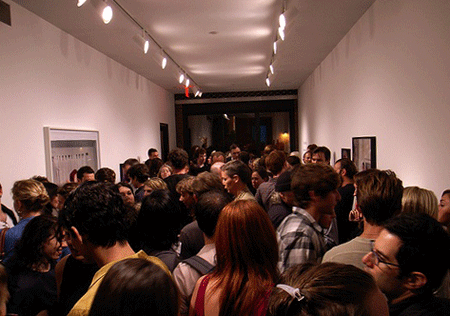The Business of Art: An Art-Market Recession Report
The opening of 31GRAND’s space on the Lower East Side, July 2007
Since last fall, a fog of uncertainty has blanketed New York’s art world as galleries, artists, and collectors have tried to make sense of the current economic recession. While the economy was still in free-fall, New York Magazine critic Jerry Saltz predicted a dire economic future: “If the art economy is as bad as it looks—if worse comes to worst—40 to 50 New York galleries will close.”
Those words were written in October, following the Frieze Art Fair in London, and from all accounts it was the month that the art market bubble burst. Daniel Cooney, of Daniel Cooney Fine Art in Chelsea, remembers the anxiety he felt as sales abruptly stopped. “Some collectors that I thought I would be able to always rely on had disappeared,” he says.
Sara Jo Romero of Schroeder Romero had the same sinking feeling. “Going into the fall was scary,” she says, “but since late November and December things picked up. We did well in Miami, where many people didn’t.”
Miami Basel’s art fair last December, a widely used barometer of the art world’s health, was lackluster at best, but that’s not to say people weren’t buying. Ed Winkleman of the Winkleman Gallery spotted a trend, saying, “Galleries were selling the artists that had an established market, people were buying the artists they knew. The question is the new talent and building a market for them from scratch.”
Art consultant Franklin Boyd of Boyd Level attended Miami Basel and noticed galleries were more eager than ever to discuss price. “The biggest question now is ‘will your check clear?’” Her hunch is that after the March fairs there may be a new wave of closings if sales don’t improve.
Boyd also sees another impending problem on the horizon: “The nonprofit side is feeling the downturn severely since many rely on dividends in terms of cash flow.” Some New York area nonprofit museums have already had board members drop off because of financial problems, and she predicts a tougher sell for the typically high-priced tickets to spring fund-raisers.
Winkleman, who has written How to Start and Run a Commercial Art Gallery(surfacing in July from Allworth Press), has been thinking a great deal about strategies to survive in bad economic times. In a January post on the Artworld Salon blog, he outlined four strategies: 1. “Closing,” which means, among other things, that some galleries may vacate their space to save on rent and take their time deciding on their next move; 2. “Money shows” instead of concept shows; 3. A “no guts, no glory” approach that forgoes sales in favor of critical acclaim; and 4. Consolidation, in which dealers join forces to weather the storm.
Ground zero for the gallery rumor mill is a blog called How’s My Dealing. The site is the art world’s secret guilty pleasure, although not one without its share of misinformation and controversy. When one anonymous commenter posted that Bellwether was going to close, owner Becky Smith was repeatedly asked if she was calling it quits. The incident lead to an email blast to her contact list clearly stating: “BELLWETHER IS NOT CLOSING.”
Rumors aside, nine city art galleries have or will close since the economic crisis began: 31GRAND, Cohan and Leslie, Guild & Greyshkul, Mehr Gallery, Fotosphere, Plane Space, Rivington Arms, Roebling Hall, and werkstatte. Many others have downsized or are faced with uncertain futures.
Johannes VanDerBeek, cofounder of Guild & Greyshkul, says that they’re sad to be shutting their doors: “[The economy] impacted us in a really immediate way. We had planned exhibitions for the whole year but around fall we realized that if we continue we might accumulate significant debt.”
“We started this to foster community and exchange but it became impossible to imagine doing that in a realistic manner with our economic outlook,” he says. Focused on closing the space responsibly, the gallery will bow out with a final group show in February.
New York City’s blue-chip galleries have been more tight lipped about their finances. PaceWildenstein announced significant layoffs in November (over 12 percent), noting they expected other galleries to follow suit in the coming months. More recently, the big auction houses have announced restructuring plans that include layoffs. According to Bloomberg, Sotheby’s has fired about 60 staffers working in its U.S. offices since mid-December, and Christie’s New York laid off 80 employees in January. These auction houses, along with Phillips de Pury, are slowly stepping away from the controversial auction guarantee system that assured buyers a certain price for their lots, widely criticized by smaller auction houses as a way to shut them out of big ticket sales. The guarantee implies a certain level of risk for the auction house, which many are now finding to be too great. Antiques Trade Gazette quotes from a Sotheby’s statement that reads: “In light of the current uncertainty in the global economy and volatility in the financial markets, we expect to continue to substantially reduce the use of auction guarantees until stability is restored.”
While most galleries are playing it safe, Pierogi 2000 in Williamsburg, Brooklyn is bucking the trend and plans to open a second neighborhood space, Pierogi Boiler, on March 7 to coincide with The Armory Show.
“It’s counterintuitive to expand, I guess, but we felt like we had to do this for our own development,” says Pierogi cofounder Joe Arnheim. “When we started the gallery in the early 1990s it was the same kind of economic environment. Now we’re living off the gallery and we’re sensitive to the market but we think that with some elbow grease we can make it,” he says. The new space will not only be a gallery but a community meeting place with plans for panels, readings, and performances.
There are a few glimmers of hope for some in the art world. Sara Jo Romero says January has been a good month and even comparable to other years. Franklin Boyd is upbeat: “After the New Year, there has been renewed interest; people are realizing that the sky hasn’t fallen.” And in the nonprofit world, the 11th Annual Visual AIDS Postcards from the Edge auction in January garnered $75,000; their most monies raised ever. One new arts group is using the economic malaise as an opportunity to change the rules of what they see as an unfair system. W.A.G.E. (Working Artists and the Greater Economy) convened for the first time last December as an activist group of artists, art workers, performers, and independent curators.
“We’re a grassroots activist group, advocating on behalf of our needs and to engage in dialogue with, and alter the landscape of, U.S. art institutions and the resulting market systems,” their spokesperson told me via email. “This is a time when there should and will be a reexamination of funding and profits….Now is the time to re-write the rules, implementing ethical and realistic systems of payment, budgeting, and support that include artists and arts workers.”
If there’s anything that everyone can agree on it’s that charting a course through the rough waters ahead is a guessing game at best. In what appears to be a move to calm collectors’ fears about their art investments, a London-based research company, ArtTactic, has devised a new Survival Rating index that grades dozens of major contemporary artists as to their potential to retain their importance in ten years’ time. Meanwhile, the company’s Western Art Market Confidence Indicator has also dipped to its lowest levels since it began in May 2005.
Collector Mike Hoeh, a hedge fund manager for a large European bank, has his own prognosis of the art world’s health. “Are art galleries closing at a higher rate than other industries? Probably not, but judging from other industries you can probably expect 10 percent of art galleries to eventually close.” With roughly 500 art galleries in New York, Hoeh’s assessment is in line with Saltz’s prediction of 50 or so shuttering of doors. Neither Hoeh’s assessment nor Saltz’s prediction have come to pass, and it’s yet unclear how bad things might still become. If anything, this uncertainty is what has made it so hard for galleries and individuals to plan for and gauge the future.
“I think everyone is waiting to find where the bottom is and then move on,” Pierogi’s Arnheim says.
Hrag Vartanian is a New York-based critic, writer, and cultural worker. He blogs daily at www.hragvartanian.com and writes regularly for the Art21 blog, ArtCal Zine and The Brooklyn Rail.





